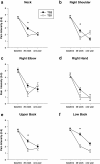Implementation of specific strength training among industrial laboratory technicians: long-term effects on back, neck and upper extremity pain
- PMID: 24106771
- PMCID: PMC3851840
- DOI: 10.1186/1471-2474-14-287
Implementation of specific strength training among industrial laboratory technicians: long-term effects on back, neck and upper extremity pain
Abstract
Background: Previous studies have shown positive effects of physical exercise at the workplace on musculoskeletal disorders. However, long-term adherence remains a challenge. The present study evaluates long-term adherence and effects of a workplace strength training intervention on back, neck and upper extremity pain among laboratory technicians.
Methods: Cluster-randomized controlled trial involving 537 industrial laboratory technicians. Subjects were randomized at the cluster level to one of two groups: training group 1 (TG1, n = 282) performing supervised strength training from February to June 2009 (round one) or training group 2 (TG2, n = 255) performing supervised strength training from August to December 2009 (round two). The outcome measures were changes in self-reported pain intensity (0-9) in the back, neck and upper extremity as well as Disability of the Arm, Shoulder and Hand (DASH, 0-100).
Results: Regular adherence, defined as at least one training session per week, was achieved by around 85% in both groups in the supervised training periods. In the intention-to-treat analyses there were significant group by time effects for pain in the neck, right shoulder, right hand and lower back and DASH-resulting in significant reductions in pain (mean 0.3 to 0.5) and DASH (mean 3.9) in the scheduled training group compared to the reference group. For TG1 there were no significant changes in pain in round two, i.e. they maintained the pain reduction achieved in round one. Subgroup analyses among those with severe pain (> = 3 on a scale of 0-9) showed a significant group by time effect for pain in the neck, right shoulder, upper back and lower back. For these subgroups the pain reduction in response to training ranged from 1.1 to 1.8.
Conclusions: Specific strength training at the workplace can lead to significant long-term reductions in spinal and upper extremity pain and DASH. The pain reductions achieved during the intensive training phase with supervision appears to be maintained a half year later.
Trial registration: ClinicalTrials.gov NCT01071980.
Figures





References
Publication types
MeSH terms
Associated data
LinkOut - more resources
Full Text Sources
Other Literature Sources
Medical

